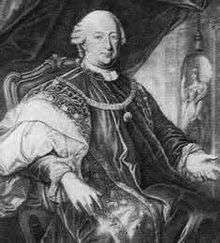Philipp von Cobenzl
| Philipp von Cobenzl | |
|---|---|
 Cobenzl in habit of the Order of the Golden Fleece | |
| State Chancellor of the Habsburg Monarchy | |
|
In office 19 August 1792 – 27 March 1793 | |
| Monarch | Francis II |
| Preceded by | Wenzel Anton, Prince of Kaunitz-Rietberg |
| Succeeded by | Johann Amadeus Francis de Paula, Baron of Thugut |
| Personal details | |
| Born |
28 May 1741 Laibach, Duchy of Carniola |
| Died |
30 August 1810 (aged 69) Vienna |
Johann Philipp, Graf von Cobenzl (28 May 1741 – 30 August 1810) was a statesman of the Habsburg Monarchy and the Austrian Empire.
Life
Cobenzl was born in Laibach, Carniola, the son of treasurer Count Guidobald von Cobenzl (1716–1797) and his wife Countess Maria Benigna von Montrichier (1720–1793).[1][2] The Cobenzl family, of Carinthian origin, was elevated to Freiherren noble rank in 1588 and raised to Imperial Counts in 1722. His cousin Count Ludwig von Cobenzl (1753–1809) served as Foreign Minister of the Habsburg Monarchy from 1801 to 1805.
Philipp von Cobenzl grew up at Predjama Castle (Burg Lueg) near Postojna (Adelsberg). He joined the Habsburg diplomatic service; in 1777 he accompanied Emperor Joseph II (in the disguise of a "Count Falkenstein") on his visit to his sister Queen Marie Antoinette in France. Immediately afterwards, Cobenzl travelled to Berlin as a Habsburg envoy, but was not able to prevent the Prussian king Frederic the Great from entering the War of the Bavarian Succession. In 1779 he concluded the Peace of Teschen and assumed the office of an Austrian vice-chancellor, eventually succeeding State Chancellor Prince Wenzel Anton of Kaunitz-Rietberg in 1792. However, already in March 1793 upon discords regarding the Second Partition of Poland, he had to resign from office in favour of Baron Johann Amadeus Francis de Paula von Thugut.
From 1801 Cobenzl worked as Habsburg ambassador in Paris. He retired in 1805, and then lived in his Döbling residence north of Vienna. He was a patron of the arts, acquainted with Wolfgang Amadeus Mozart, and greatly contributed to the education and career of the Neoclassicist painter Franz Caucig.[3] In 1809, he informed Napoleon Bonaparte about the demographics of the newly established Illyrian Provinces.
Upon his death, the Cobenzl noble dynasty became extinct. He was buried in the Vienna St. Marx Cemetery. A street in the Döbling district was named after him in 1894.
Notes
Regarding personal names: Until 1919, Graf was a title, translated as Count, not a first or middle name. The female form is Gräfin. In Germany since 1919, it forms part of family names.
See also
References
- ↑ ADB:Cobenzl, Philipp Graf von at de.wikisource.org
- ↑ Kamin Kajfež, Vesna (2010). "Franc Kavčič (Caucig) in egiptomanija" [Franc Kavčič (Caucig) and Egyptomania] (PDF). Annales, Series Historia et Sociologia (in Slovenian, English, and Italian). Scientific and Research Institute of Koper, University of Primorska. 20 (2): 363–364. ISSN 1408-5348.
- ↑ Rozman, Ksenija (October 2007). "Franc Kavčič/Caucig: Paintings for the Palais Auersperg in Vienna". National Gallery of Slovenia. Retrieved 12 February 2012.
Further reading
- Alfred von Arneth: Graf Philipp Cobenzl und seine Memoiren. – Wien : Carl Gerolds Sohn, 1885